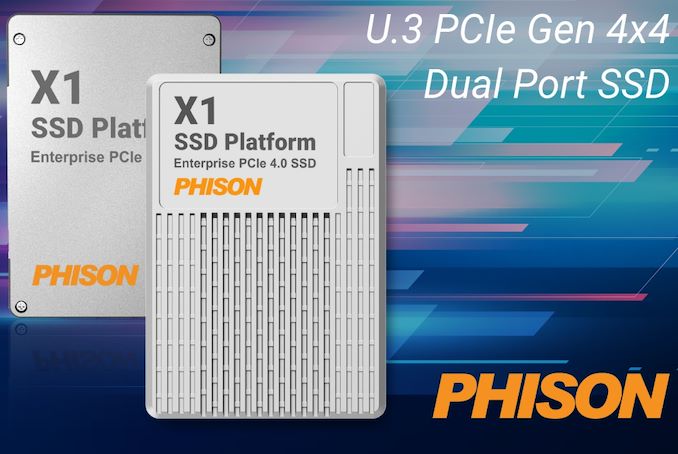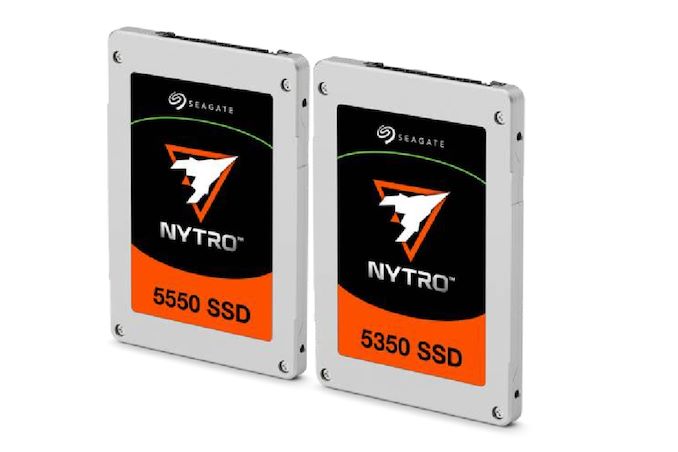Phison and Seagate Announce X1 SSD Platform: U.3 PCIe 4.0 x4 with 128L eTLC
by Ganesh T S on August 2, 2022 8:00 AM EST
Phison and Seagate have been collaborating on SSDs since 2017 in the client as well as SMB/SME space. In April 2022, they had announced a partnership to develop and distribute enterprise NVMe SSDs. At the Flash Memory Summit this week, the results of the collaboration are being announced in the form of the X1 SSD platform - an U.3 PCIe 4.0 x4 NVMe SSD that is backwards compatible with U.2 slots.
The X1 SSD utilizes a new Phison controller exclusive to Seagate - the E20. It integrates two ARM Cortex-R5 cores along with multiple co-processors that accelerate SSD management tasks. Phison is touting the improvement in random read IOPS (claims of up to 30% faster that the competition in its class) as a key driver for its fit in AI training and application servers servicing thousands of clients. The key specifications of the X1 SSD platform are summarized in the table below. The performance numbers quoted are for the 1DWPD 3.84TB model.
| Seagate / Phison X1 SSD Platform | |
| Capacities | 1.92 TB, 3.84 TB, 7.68 TB, 15.36 TB (1DWPD models) 1.6 TB, 3.2 TB, 6.4 TB, 12.8 TB (3DWPD models) |
| Host Interface | PCIe 4.0 x4 (NVMe 1.4) |
| Form Factor | U.3 (15mm / 7mm z-height) |
| NAND | 128L 3D eTLC |
| Sequential Accesses Performance | 7400 MBps (Reads) 7200 MBps (Writes) |
| Random Accesses Performance | 1.75M IOPS @ QD32T4 & 84us Latency @ QD1 (4K Reads) 470K IOPS @ QD32T4 & 10us Latency @ QD1 (4K Writes) |
| Uncorrectable Bit-Error Rate | 1 in 1018 |
| Power Consumption | 13.5W (Random Reads) 17.9W (Random Writes) 6.5W (Idle) |
Seagate equips the X1 with eTLC (enterprise TLC), power-loss protection capacitors, and includes end-to-end data path protection. SECDED (single error correction / double error detection) and periodic memory scrubbing is done for the internal DRAM as part of the ECC feature. For the contents on the flash itself, the X1 supports the Data Integrity Field / Data Integrity Extension / Protection Information (DIF/DIX/PI) for end-to-end data protection. Various other enterprise-focused features such as SR-IOV support, and NVMe-MI (management interface) are also supported.
Seagate and Phison claim that the X1 SSD can be customized for specific use-cases, and it offers the best performance in class along with the best energy efficiency. Seagate is marketing the X1 SSD under the Nytro branding - the Nytro 5050 NVMe SSD series for data centers. The Nytro 5350 consists of the 1DWPD models, while the Nytro 5550 makes up the 3DWPD ones.
In terms of competition in the PCIe 4.0 / U.2 / U.3 space, the Nytro 5050 series goes up against Micron's 7450 PRO and 7450 MAX (PDF), using their 176L 3D TLC flash, and Kioxia's CD7-V / CD7-R data center SSDs. On paper, Seagate / Phison's performance specifications easily surpass those platforms that have been shipping for more than a year now.
Source: Phison











14 Comments
View All Comments
ballsystemlord - Tuesday, August 2, 2022 - link
@Ganesh Your "source" link is broken and it goes to AT "https://www.anandtech.com/show/17517/www.phison.co...Threska - Tuesday, August 2, 2022 - link
Hopefully the carbon footprint of these new SSDs are good.https://www.discovermagazine.com/technology/the-di...
AusMatt - Wednesday, August 3, 2022 - link
"the lifetime footprint for a 1 terabyte SSD is 369.2 kg of carbon dioxide equivalent versus 199 kg for an HDD. So HDDs are much cleaner" and "they say their analysis does not account for the impact of SSDs on overall performance".StevoLincolnite - Sunday, August 14, 2022 - link
Does that take into account the effect it has on other components? SSD's load faster than spinning rust drives, which means more time your PC is consuming electricity.TheinsanegamerN - Wednesday, August 10, 2022 - link
"muh CO2"!!11!!!!I'm sure gretta will send you a thank you card.
PeachNCream - Thursday, September 1, 2022 - link
I think we all can agree that overpopulation is the key problem that causes humans to adversely impact Earth and soil their proverbial cage. Its a pity that the lower band of socioeconomic people tend to have the most children and thus pass on their poor quality of life, bad decision-making skills, and reduced drive resulting in people that ridicule those that have an interest in being responsible caretakers for our planet.With all that said, we are well past the point where we should have been analyzing and reconsidering the full impact of all the things we do from football and auto sports to excessively wasteful compute capabilities. Carbon footprint analytics and efforts to raise awareness about such things are encouraging glimmers of hope that we can do better despite a few lost cause throwbacks that have absorbed mis- and disinformation from the social media and family echo chambers they unfortunately live in.
Wrs - Tuesday, August 2, 2022 - link
The table is misleading. 1.75M IOPS is only for high queue depth random reads. For a moment I thought someone had figured how to dethrone Optane with NAND.SSD_Guy - Wednesday, August 3, 2022 - link
Yeah, my guess is a LOT of those those specs are misleading, or there is a missing asterisk with 3 pages of non-standard testing parameters. My guess is the old SandForce guys are infecting Phison with their benchmarking shenanigans.SSD_Guy - Wednesday, August 3, 2022 - link
I figured it out, look at the linked datasheets, those specs are for a 24W(!) product, and they don't even match the article (latency/UBER). The performance of the of the M version (not H) is at or below the specs of Kioxia and Micron for the same power draw.ganeshts - Wednesday, August 3, 2022 - link
This is the X1 spec - https://www.phison.com/phocadownload/X1-SSD/128581... . Where do you see latency / UBER not matching?I did add the clarification on the IOPS ratings.